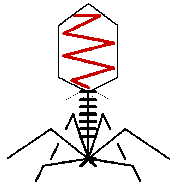

Nucleases
Nucleases are ubiquitious enzymes indispensable for cellular and viral development on the DNA- (DNAses) and the RNA-level (RNAses). Processes under control of nucleases are for example protective mechanisms against "foreign" (invading) DNA, degradation of host cell DNA after virus infections, DNA repair, DNA recombination, DNA synthesis DNA packaging in chromosomes and viral compartments, maturation of RNAs or RNA splicing.
Nucleases are phosphoidesterases with a tremendous variability in their substrate requirements. They are classified by their specificity as EXO- or ENDO-nucleases meaning they require either a free end (exo) to start working or they start from anywhere within a molecule (endo) even when no free ends are available as for example in a covalently closed circle. Some nucleases have both, endo-and exo-activities. Some are specialized for single-stranded DNA (ss-DNA) others for double-stranded DNA (ds-DNA); again, some nucleases can work on both types of DNAs. Further, some exonucleases work in a 3'->5' direction, others in a 5'->3' direction; some do not care and work in both directions. Some endonucleases comprise site-specificity and require distinct sequences for cleavage others require helper proteins to find their targets. Finally, there are nucleases which combine both, exo- and endo-activities in the same protein, and there are nucleases which come together with other functions on the same protein, though in different functional sections (domains). The development of phage T4 depends on a series of self coded DNAses. One of them is endonuclease VII (endo VII) which was originally described as an enzyme required for efficient packaging of newly replicated DNA into preformed preheads late during the infection cycle. Endo VII is the product of gene 49 (gp49), and mutants in this gene are consequently deficient in completing properly initiated processes of DNA packaging into heads. Biochemical analyses and electron microscopical inspections of non-packagable mutant gene 49- DNA suggested that the packaging process was physically interrupted by frequently ocuring branches as they were made during replication or recombination earlier during the infection cycle.
 Bacteriophage T4
Bacteriophage T4